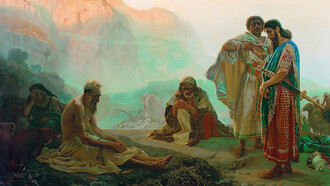This is the first of a series of articles on the I Ching, or Yijing, the Book of Changes, an ancient oracle, a divinatory book that played a key role in Chinese culture and became for the Chinese a map of 'heaven and earth', of the totality of existence. Much of this material is contained in the Introduction to the Eranos Yijing1. To that book the reader is referred for a deeper discussion of the concepts here presented.
Having its origin in shamanic practices of the third millennium BCE, it took form as a book around the seventh or eighth century BCE, became a classic (a ching or jing) under the Han dynasty (206 BCE - 220 CE) and was held in the highest regard throughout Chinese history for the next 2000 years. It became known in the West thanks to the German translation of Richard Wilhelm (published in Jena in 1923) and especially to the foreword Carl Gustav Jung wrote for Wilhelm's book. To this day most Western versions of the Yijing are translations of Wilhelm's translation.
As an oracle, the book is supposed to answer questions about the unknown, which makes it a precious ally when we are confronted with life's vagaries, uncertainties and dramas. But can it be so? Can an ancient Chinese book answer questions concerning our present life situation? Obviously relating to the Yijing in such a way implies a radically different notion of space and time. In Riding the Waves of Change we will muse over such questions while describing the oracle's origin and divinatory use.
The Book of Changes
What kind of changes are hinted at in the name of the Book of Changes? Yi refers primarily to all natural cycles, to the alternating of day and night, to the round of the seasons, to the organic process of growth and decay, and to the mirroring of these cycles in human life. In the philosophical thought of ancient China this alternance of complementary opposites is represented by the interplay of two basic principles, yin and yang, night and day, receptive and active, feminine and masculine, moon and sun, etc. (more about that later). Therefore the change the title of the book alludes to is primarily the eternal round of yin and yang transforming into each other. But it refers also to another type of change: unpredictable change, the irruption of the unexpected, disorder, chaos. This other type of change is thus described in the Shujing, the Book of Documents:
When in years, months and days the season has no yi, the hundred cereals ripen, the administration is enlightened, talented men of the people are distinguished, the house is peaceful and at ease. When in days, months and years the season has yi, the hundred cereals do not ripen, the administration is dark and unenlightened, talented men of the people are in petty positions, the house is not at peace2.
We have yi when things are off-track, when chaos irrupts into our life and the usual bearings no longer suffice for orientation. Such times can bring about great learning – and can be painful, disconcerting and full of anxiety. Modern chaos theory pays special attention to these transitions, to the lapse into disorder by which forms transmute into each other. Life itself arises at the boundary between order and chaos: it requires both, it is a daughter of both. On the side of complete order there is dead stability, complete symmetry, the inertia of a perfect crystal: everything is too predictable, it resembles death more than life. But the side of total disorder is not very interesting either: forms appear and disappear too fast, there is a total lack of symmetry, everything is too unpredictable. It is on the edge between order and chaos that the subtle dance of life takes place: here the real complexity arises, here forms bend and loop and transmute and evolve.
The Yijing is the ancient Chinese map of this dance of order and chaos. Its texts, as we will see, have their origin in shamanic pronouncements given in altered states of consciousness. They are wild, imaginal statements with minimal outer coherence. They come from the psychic dimension Henri Corbin called "mundus imaginalis." But in the book this wild dimension is harnessed into the orderly philosophy of the yin and yang principles. Thus the Yijing is a bridge: a bridge between the shamanic and the philosophical mind, a bridge between the subconscious and the conscious psyche, a bridge between chaos and order.
In the Yijing the interplay of yin and yang is encoded in sixty-four hexagrams, figures composed of six broken (corresponding to yin) or whole (corresponding to yang) lines. The sixty-four hexagrams represent all the fundamental combinations of the basic principles, all the fundamental archetypal energy configurations in "heaven and earth". And to each one of them, and to each of the constituent lines, is appended a judgement evoking the nature of that particular energy configuration.
But the book did not originate as a philosophical text, although it has been used that way, and as such it has attracted a huge amount of philosophical commentary. It was born in the first millennium BC as a divination manual, i.e. as a practical tool to help people ride the waves of change, a tool to deal with yi, with critical times. In many ancient cultures these times were seen as intrusions of the divine, of gods and spirits, into human life, and interrogating these higher powers, engaging them in a dialogue, was seen to be the appropriate way to handle the crisis. This dialogue, in many cultures all over the world, took the form of the practices we call divination. The Yijing was born and kept being used throughout its long history as one such method of divination, as an oracle.
Synchronicity
Like many other forms of divination, the oracular practice of the Yijing relies on what in modern scientific terms we call a random procedure. The traditional method of consultation consists in repeatedly randomly dividing a bunch of yarrow stalks (achillea millefolium), and counting the stalks in the resulting two bunches in a specific way. A more modern method (Southern Song dynasty, ca 1200 CE) consists in tossing three coins six times. Other divination practices may involve geomancy, tarot cards, reading tea leaves in the bottom of a cup, etc.
A large majority of scientists dismiss divination altogether as nonsense: in modern scientific jargon anything "random" is by definition meaningless. But of course "random" is a delicate concept: is there anything truly random?
In modern physics we know only two types of "true randomness"3: symmetry breaking in complex systems and quantum indeterminacy. Both of these are essentially unpredictable, they are "truly random," as far as we can tell. But does that mean that they have no meaning or that they do not participate in a cosmic symphony of meaning? Wolfgang Pauli spoke of quantum indeterminacy as "an act of creation." That is definitely a different way of looking upon randomness.
However that may be, for the ancient Chinese nothing was truly random, nothing was entirely devoid of meaning. Their divinatory practices and their whole cosmology were based on a qualitative notion of time, in which all things happening at a given moment in time share some common features, are part of an organic pattern. Nothing therefore is entirely meaningless, and the entry point to understanding the overall pattern can be any detail of the moment, provided we are able to read it. This has been very well described by C.G. Jung in his classic foreword to the Wilhelm's translation of the Yijing . He writes:
The Chinese mind, as I see it at work in the I Ching, seems to be exclusively preoccupied with the chance aspect of events. What we call coincidence seems to be the chief concern of this peculiar mind, and what we worship as causality passes almost unnoticed...
The matter of interest seems to be the configuration formed by chance events in the moment of observation, and not at all the hypothetical reasons that seemingly account for the coincidence. While the Western mind carefully sifts, weighs, selects, classifies, isolates, the Chinese picture of the moment encompasses everything down to the minutest nonsensical detail, because all the ingredients make up the observed moment.Thus it happens that when one throws the three coins, or counts through the forty-nine yarrow stalks, these chance details enter into the picture of the moment of observation and form a part of it - a part that is insignificant to us, yet most meaningful to the Chinese mind...
In other words, whoever invented the I Ching was convinced that the hexagram worked out in a certain moment coincided with the latter in quality no less than in time. To him the hexagram was the exponent of the moment in which it was cast -even more so than the hours of the clock or the divisions of the calendar could be - inasmuch as the hexagram was understood to be an indicator of the essential situation prevailing in the moment of its origin.
This assumption involves a certain curious principle that I have termed synchronicity, a concept that formulates a point of view diametrically opposed to that of causality... Synchronicity takes the coincidence of events in space and time as meaning something more than mere chance, namely, a peculiar interdependence of objective events among themselves as well as with the subjective (psychic) state of the observer or observers"4.
The way in which the oracular use of the Yijing relates to the configuration of events at any given moment is therefore more akin to the perception of a work of art than to a rational analysis of cause and effect. It is a rich tapestry of meaning, in which all details are subtly connected and somehow necessary – not because of deterministic laws, but because they are part of an organic whole. Of course the Chinese were aware of the existence of causal connections between events; but that aspect was relatively uninteresting to them. On the contrary they were fascinated by subtler, more complex and less exactly definable connections. The Western notion that comes closest to their approach is Jung's idea of archetypes"5, and it is no chance that Jung was deeply interested in the Yijing. He saw the ancient Chinese oracle as a formidable psychological system that endeavors to organize the play of archetypes, the "wondrous operations of nature" into a certain pattern, so that a "reading" becomes possible"6.
The Yijing can therefore be viewed as a catalog of sixty-four basic archetypal configurations, a road map to Jung's collective unconscious and to Corbin's mundus imaginalis"7.
1 Rudolf Ritsema and Shantena Augusto Sabbadini, The Original I Ching Oracle or the Book of Changes, Watkins, London, 2005, 2018.
2 Bernhard Karlgren, The Book of Documents, Stockholm, 1950, p. 33.
3 By "true randomness" I mean not the apparent randomness that is just lack of sufficient information. E.g., tossing a coin: how the coin will fall is for all practical purposes random. Yet I would be able to predict it exactly if I only knew in all detail the initial conditions of the toss, the friction with the air, the local value of the force of gravity, etc.
4 C. G. Jung, Foreword to The I Ching, or Book of Changes, Richard Wilhelm Translation, Bollingen Series XIX, Princeton University Press, 1950.
5 See, e.g., C.G. Jung, The Archetypes and the Collective Unconscious, CW 9, I, Bollingen Series XX, Princeton University Press, 1959, 1969.
6 C.G. Jung, Mysterium Coniunctionis, CW 14, 401, Bollingen Series XX, Princeton University Press, 1963, 1970.
7 Henry Corbin, "Mundus imaginalis, or the Imaginary and the Imaginal", in Swedenborg and Esoteric Islam, trans. Leonard Fox, Swedenborg Foundation, West Chester, PA, 1995.















